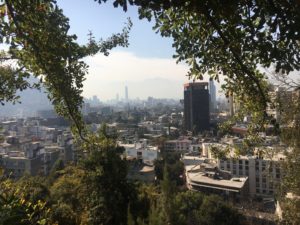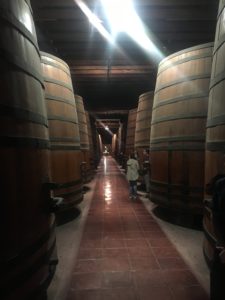After nearly 36 total hours of traveling, including a daylong layover in Atlanta thanks to New York weather, I made it to Santiago, Chile. After the 9 hour flight from Atlanta to Santiago, I was pulled straight from the airport to the hotel, where I disposed of my bags and jumped right into orientation with the rest of my group, which (for the most part) had arrived a day earlier.
Following our first meeting, we began to tour the city, getting right into it with a climb up Santa Lucía Hill. I tried to soak up the history surrounding the hill while trying to make it up and down the uneven concrete steps without wiping out in front of everyone. The struggle was worth it in the end, as we got amazing panoramic views of the city, blanketed by the surrounding Andes.

We then continued the tour by visiting Plaza de Armas de Santiago, a main square in the city. There I witnessed my first Chilean demonstración, or protest, orchestrated by a group of young female students fighting for greater gender equality within schools. From afar, they seemed quite young, so it was really intriguing to see people of all ages engaging in sociopolitical issues within the country. Our leaders told us that many college students are on strike in Chile because of those issues. We later got a tour of La Moneda, which is practically the Chilean White House. Standing under the office of the president himself, we learned about the history of the building, which initially began as a mint.
On the next day, we toured of the country’s most famous wineries, Viña Cousiño Macul, and got to learn about the process of fermentation. Furthermore, it was really cool to see the personal wine collection of the Cousiño Macul family. We continued our tour of Santiago by visiting La Chascona, the home that famous Chilean poet Pablo Neruda built for his third wife, Matilde. The house’s intricate architecture and structure made it quite unique, especially given its position on a hill.

Throughout my time here so far, I have definitely experienced difficulties understanding Chilean Spanish. They speak very quickly and omit the letter ‘s.’ When speaking to us, our leaders have been cognizant of this extreme difference and have made an effort to more explicitly pronounce their words. They have also ensured us that once we begin to grasp Chilean Spanish, arguably one of the most difficult variations of the language, we will become much better at understanding all types of Spanish.
During our final morning in Santiago, we went to Los Domínicos, a small district of artisans towards the outskirts of the city. I really got a feel for the Chilean culture as I viewed many types of beautiful jewelry and ate empanadas. Tons of families spent their Saturday there, and it was a beautiful, peaceful way to spend my last day in Chile’s capital city. Off to Valparaíso and Viña del Mar to meet my host family and get settled in!